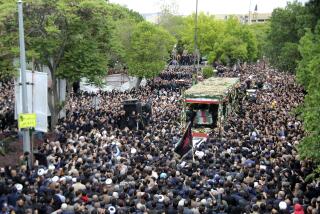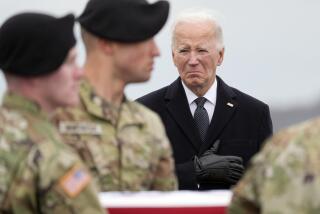A private tribute to the fallen
- Share via
FORWARD OPERATING BASE BASTION, AFGHANISTAN — The word went out across the flight line: “Ramp ceremony!”
Two “angels,” the remains of a U.S. Marine and his Afghan interpreter, were about to be loaded onto a cargo plane Friday night. Four dozen soldiers and Marines quickly lined the runway to pay a final, poignant tribute to the dead.
Ramp ceremonies have been painfully common in Afghanistan this spring. Roadside bombs are killing U.S. and coalition service members at a high rate, leading to many solemn plane-side tributes.
The events are reverential, dignified and almost majestic in their stark simplicity. But the Pentagon refuses to allow the news media to cover or photograph them, thus denying the American public a look at an enduring military ritual.
A Department of Defense regulation, “Release of Photos and Information Pertaining to War,” cites privacy of the dead and their families. Invoking those regulations, military public affairs officers told two Times journalists to leave a ramp ceremony in Kandahar on Saturday night. Yet the night before, the same reporters were invited by Marines to join service members lined up to salute the dead at the Bastion base.
The Pentagon policy is part of what critics allege is an effort to censor the most searing images of war, sanitizing the suffering and death after nearly seven years of a grinding insurgency in Afghanistan. A similar 1991 regulation prohibits photographs of flag-draped coffins of war dead, particularly at Dover Air Force Base in Delaware, where remains are taken to a military morgue for transport home.
Despite Pentagon restrictions, a few iconic images have emerged: a photo taken the moment an Army sergeant realized a body bag contained the remains of a close friend in the 1991 Persian Gulf War, and photos of flag-draped caskets from the current conflict in Iraq, taken by a contract worker aboard a flight leaving Kuwait in 2004.
The Pentagon tends to prefer upbeat and noncontroversial images. Public affairs officers regularly encourage journalists to cover battlefield promotion and reenlistment ceremonies, and the handing out of soccer balls to Afghan or Iraqi children.
Though ramp ceremonies are shrouded from the public eye, they embody the ritual honors and minimalist pageantry so beloved by the military. Fallen soldiers are anonymous, their flag-draped caskets unmarked and representing all America’s war dead.
For reporters hitching rides on military aircraft in Afghanistan, the ceremonies are an unavoidable feature of airfield landscapes. In addition to the Marine and the Afghan interpreter, four U.S. troops and a Polish soldier were killed on Friday and Saturday alone. The ramp ceremony at Bastion, in Helmand province, was the second there in two days, after the deaths of two Navy corpsmen in an insurgent attack Wednesday.
The Pentagon ban on is haphazardly enforced and poorly understood, even by many public affairs officers.
On Saturday, one such officer escorted Times journalists to cover and photograph the ramp ceremony in Kandahar for five U.S. service members. On the way, she announced that no photographs could be taken of the flag-draped coffins. Then, after conferring with another public affairs officer who had just read the regulations, she said no journalists would be allowed at all.
The reporters watched the ceremony from behind a fence. Later, the officer apologized and said the journalists should have been allowed to attend the ceremony, as long as they agreed to not write about it or take photographs.
The ceremonies are emotional, all the more so this spring as casualty rates have soared amid a Taliban resurgence in southern Afghanistan. At least 55 U.S. service members have died in Afghanistan this year, according to icasualites.org, an independent website that tracks casualties in the Iraqi and Afghan conflicts. At the current pace, U.S. deaths in Afghanistan in 2008 will approach last year’s total of 117, by far the deadliest year since the U.S.-led invasion in late 2001.
In May, for the first time, the number of U.S. dead in Afghanistan exceeded the monthly total in Iraq. Before June, no more than two coalition soldiers had been killed this year in any single attack. In a three-day period last week, four Marines and four British soldiers were killed in separate roadside bombings.
Like insurgents in Iraq, the Taliban relies on roadside bombings and hit-and-run attacks to inflict slow, steady casualties on coalition forces. In rare instances where the militants fight head-on, they are crushed.
For four weeks in May, for instance, U.S. Marines lost one man in fighting that killed scores of Taliban and drove insurgents from their strongholds in the southern province of Helmand, the world’s leading opium-producing region. Yet in a three-day period early last week, the Marines lost four men to roadside attacks.
The Marine killed Friday with his interpreter had been dead only a few hours when his remains, sealed in a dark green body bag, were carried by colleagues past columns of saluting soldiers and Marines near the rear ramp of a C-130 cargo plane. Two reporters joined the columns, holding their hands over their hearts instead of saluting.
An American flag was strapped to the Marine’s body bag. Other Marines carried the remains of the interpreter, in a similar body bag with no flag. His corpse received no salute.
There were no remarks, no spoken prayers -- just the sharp cadences of a Marine calling out commands: “Atten-shun” and “pree-sent arms.” The remains were carried past the columns, slowly, as if to maximize the tribute. Those in formation saluted.
The crew chiefs from the plane strapped the body bags to the deck with the same type of straps that hold down cargo pallets. The remains lay beneath an American flag the crew had hung inside the aircraft. Then the big plane was aloft, bound for Kandahar and, for the Marine, the trip home to the U.S. via Germany. In flight, the crew chiefs stepped gingerly around the body bags, keeping a respectful distance.
A few feet away sat four Marines who had been part of the ramp formation. With them was an Afghan interpreter who had also paid his respects along the ramp. They sat in silence, heads bowed, for the entire 35-minute flight.
In Kandahar the next evening, more than 1,000 service members from several countries were on the flight line for a far larger ceremony honoring the Marine killed Friday and four U.S. soldiers killed Saturday. There were American soldiers, Marines and airmen, and troops from Britain, Canada and Lithuania.
Two Humvees and a cargo truck brought the five sets of remains in metal coffins, each one draped in an American flag. The men and women in the columns saluted and held those salutes for many long minutes.
A chaplain said a prayer and spoke of each fallen man. “He knew what it meant to live out the creed -- mission first, men always,” he said of one. Of another, he said, “He put the needs of the country before his own.”
Eight-man details carried the caskets down the long, empty stretch of runway left open by the formations.
A piper sounded. The high notes of the bagpipes floated across the tarmac. When the piper played the Marine Corps hymn -- not once, but several times -- some of the Marines fought back tears.
Then came the low, plaintive notes of taps that cut through the thin evening air. Soon the details had loaded the caskets into the plane’s belly. The big metal ramp rose up and slammed shut on the five caskets all in a row.
At the base fire station at the edge of the flight line, Fire Chief Bill MacDonald did not attend. He and his firefighters used to faithfully show up for every ramp ceremony, he said, but no more.
There have been 80 such ceremonies since July, the chief said. He meant no disrespect to the dead of any nation, he said, but watching all those caskets was taking a psychological toll on him and his men.
“It just got to the point we couldn’t go out there anymore,” he said, watching the C-17 maneuver beneath a dull orange sun setting behind the murky silhouette of a distant mountain. “It was just too much to take.”
--
More to Read
Sign up for Essential California
The most important California stories and recommendations in your inbox every morning.
You may occasionally receive promotional content from the Los Angeles Times.












